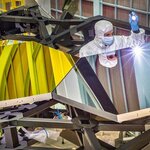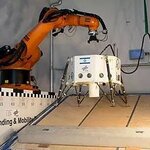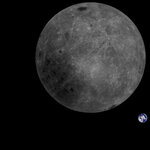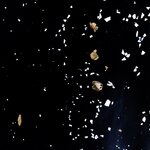Aerospace

Smart spacesuits and solar surfing may sound like the stuff of science fiction, but they are just two of the technology concepts NASA has selected for further research as part of the NASA Innovative Advanced Concepts (NIAC) program. The program will fund 18 studies to determine the feasibility of early-stage technologies that could go on to change what's possible in space.
The funded technologies have the potential to transform human and robotic exploration of other worlds, including the Moon and Mars. One researcher, for example, will study an affordable way to mine the ample…

Since 1990, the U.S Government Accountability Office (G.A.O.) has had NASA on its High Risk list due to persistent cost inflation and missed schedules.
Well, NASA is bold adventure, right? Doing things no one else can do? Bureaucratic timetables can't stand in the way of science. Except just the opposite is true. GAO regards NASA as a job works program for the opposite reason than that its missions are too bold for terrestrial accountants - it promises a lot and then once government is on the hook for the money, fails to deliver.
There have been successes, sure, for small projects. I like…

A short few months after China became the third country with a moon mission (following the United States and the Union of Soviet Socialist Republics), Israel will be the fourth.
On February 22nd, 2019, give or take weather events, the Beresheet Moon lander, once one of the candidates for the Google Lunar X-Prize, will make Israel the fourth country with a moon mission. And its $100 million for planning and execution has been made possible through cooperation of private individuals, corporate and government groups, and academia.
Originally named Sparrow, the Israeli unmanned Moon mission…

In January, the Chang’e-4 lunar probe landed on dark side of the Moon but it's a tiny relay satellite that is getting all of the buzz today.
The Chinese Lunar satellite DSLWP-B (Longjiang-2) took a picture of Earth and the far side of Luna, the Dwingeloo telescope downloaded it, and now the public is enchanted. The tiny 20-inch satellite is used so ground control can communice with Chang’e-4 and the Dwingeloo telescope assists because communications signals go in a straight line, so they sometimes need to bounce to get to their target. Because of tidal locking by earth, the same…

Traveling to Mars is a ridiculous idea outside anything but "adventure" yet the U.S. administration under President Obama scrubbed his predecessor's return to the moon and replaced it with a program bearing his name, going to the red planet.
Whether or not that actually happens, science and technology are using that potential to experiment with growing food in space.
In 2021, beans are scheduled to be grown in space, planted in high-tech planters developed at the Norwegian University of Science and Technology (NTNU). This follows growing lettuce that has already occurred on the…

Half a century of Christmases ago, the NASA space mission Apollo 8 became the first manned craft to leave low Earth orbit, atop the unprecedentedly powerful Saturn V rocket, and head out to circumnavigate another celestial body, making 11 orbits of the moon before its return. The mission is often cast in a supporting role – a sort of warm up for the first moon landing. Yet for me, the voyage of Borman, Lovell and Anders six months before Neil Armstrong’s “small step for a man” will always be the great leap for humankind.
Apollo 8 is the space mission for the humanities, if ever there was one…

Adélies penguin species may disagree that we're the apex species on earth; they don't spend a lot of time analyzing our poop after all.
But using Landsat satellite images, a team of scholars hope to use poop to sound another warning about clmate change. Unlike "Mission Impossible" movies, not every satellite can see individual creatures, but it can gauge changes by their traces; in this case, pink poo.
It's not possible to know how many such penguins there are, and how that has changed over longer periods of time, because surveys are even less accurate for penguins than they are…

Steph Curry of the Golden State Warriors may not be certain (1) man landed on the moon but if photos and broadcasts of that are not enough, he won't be fooled by this picture of an Elf On The Shelf (Jingle, my wife calls him; Kegel the Christmas Elf, as fans of The League deem him) on the International Space Station.
Yet there he is, snapped by astronaut Anne McClain and beamed back to terra firma. NASA sure has changed. Gus Grissom got criticized for even eating a corned beef sandwich on board a Gemini capsule, but Jingle Kegels don't leave behind crumbs. Or if they do, it's, you know...poop…

NASA's InSight experiment landed on Mars November 26th after traveling 300 million miles over seven months. Though it is there to analyze seismic activity. its seismometer and air pressure sensor and picked up different vibrations on Dec. 1st.
The slight hum turned out to be 10-15 mph winds as they blew across Mars’ Elysium Planitia.
We can now hear sound on another planet.
"Capturing this audio was an unplanned treat," said Bruce Banerdt of the Jet Propulsion Laboratory in their press release.
For you and me both.
There's not a lot I can add to that so I will just be awed.

In the journal Monthly Notices of the Royal Astronomical Society and in a presentation at the European Week of Astronomy and Space Science in Liverpool, a team announced one of the largest 3D maps of the infant Universe.
And along with it almost 4,000 early galaxies, many of which will have evolved into galaxies like our own Milky Way.
The COSMOS field in the constellation of Sextans, seen in infrared light. Credit: ESO/UltraVISTA team. Acknowledgement: TERAPIX/CNRS/INSU/CASU
Looking back in time: 16 different epochs between 11 and 13 billion years ago
Light from the most distant…